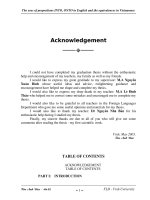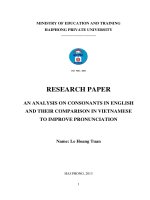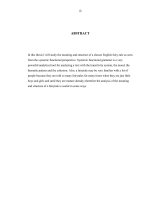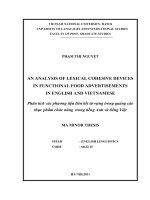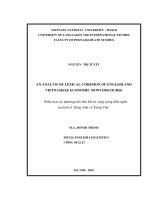An analysis on English compound nouns and Vietnamese equivalence
Bạn đang xem bản rút gọn của tài liệu. Xem và tải ngay bản đầy đủ của tài liệu tại đây (343.92 KB, 53 trang )
1
ACKNOWLEDGEMENT
First of all, I would like to express my sincere and special gratitude to Ms. Le Thi
Hong (M.A) and Ms. Nguyen Thi Phi Nga (M.A), my supervisors, who have
generously given us invaluable assistance and guidance during the preparation for
this graduation paper.
I also offer my sincere thanks to Ms. Tran Thi Ngoc Lien, the Dean of Foreign
languages Department and all the teachers at Hai Phong Private University for their
previous lectures that helped me in preparing my graduation paper.
Finally, my wholehearted thanks are presented to my family and all of my friends
for their constant supports and encouragement in the process of doing this paper.
My success in researching is contributed much by all of you.
Hai Phong- June 2009
Doan Thi Chi
2
TABLE OF CONTENTS
PART ONE: INTRODUCTION……………………………………………………4
1. Rationale of the study…………………………………………………….4
2. Scope of the study…………………………………………………… 5
3. Method of the study……… …………………………………………… 5
4. Application places……………………………………………………… 6
5. Design of the study……………………………………………………….6
PART TWO: DEVELOPMENT……………………………………………… 9
Chapter one: THEORETICAL BACKGROUND……………………………… 9
1.1 An overview of English compound nouns………………… 9
Definitions……………………………………………………… 9
Types of English compound nouns…………………………… 10
Basic compound nouns…………………………………………10
Complex compound nouns…………………………………… 10
1.2 Classifications of English compound nouns………………………… 17
1.2.1 According to the meaning ………………………………………… 17
1.2.1.1 Idiomatic compound nouns…………………………………… 17
1.2.1.2 Non-idiomatic compound nouns………………………………… 18
1.2.2 Classification according to the componental relationship…………… 19
1.2.2.1 Subordinate compound nouns…………………………………… 19
1.2.2.2 Coordinate compound nouns………… ………………………… 21
3
Chapter two: AN INVESTIGATION INTO ANALYSIS ENGLISH
COMPOUND NOUNS AND VIETNAMESE EQUIVALENCE……………… 22
2.1 Notion of English compound nouns…………………………………… 22
2.2 Vietnamese compound nouns…………………………………………….24
2.3 English compound nouns versus Vietnamese compound nouns…………28
2.3.1 Similarities…………………………………………………… 28
2.3.2 Differences………………………………………………………… 33
2.4 An analysis on English compound nouns and Vietnamese
equivalence … 35
2.4.1 Equivalence case in English compound nouns and Vietnamese
compound nouns………………………………………………………………… 35
2.4.2 Non-equivalence case in English compound nouns and Vietnamese
compound nouns………………………………………………………………… 39
Chapter three: SOLUTION FOR NON-EQUIVALENCE
CASES…………………………………………………………………… 46
3.1 Differences in form……………………………………………………… 46
3.1.1 With the help of affixes cases…………………………………………46
3.1.2 With the help of related word cases………………………………… 48
3.2 Differences in frequency and purpose of using specific forms… 48
PART THREE: CONCLUSION………………………………………… 51
1. Summary of the study……………………………………………… 51
2. Suggestion for further study………………………………………………….52
List of references…………………………………………………… 53
4
Part I: Introduction
1. Rationale of the study:
Nowadays, in the era of science and technology, language as a means of
communication, has shown its great effects in many fields of our life. It takes part
in people‟s activities, such as economy, education, society and so on. Thus,
language is also considered as a decisive factor for the development process of
society. When a language is developed, its vocabulary is always in constant
development. At that time, the vocabulary is used to express new ideas, concepts to
reflect people‟s activities, characters and mentalities.
However, in the grammatical system there is a distinction which is called language
barrier. Especially, that important distinction is compound nouns. During my study
time at the University I have found that many students meet problems in using
English compound nouns and Vietnamese equivalence. They may be, don‟t
understand clearly the structures of compound words, which lead to misunderstand
the meanings of these words.
Therefore, being aware of the importance of vocabulary in communication and the
distinction in the grammatical system, I finally decided to choose English
vocabulary as the study for B.A research paper. My objective focuses on analyzing
on English compound nouns and Vietnamese equivalence.
In this paper, the words “compound nouns” is defined as the combination two or
more different words that help to make up different meanings of these compound
nouns. Besides, in this graduation paper, errors and mistakes are unavoidable. All
remarks and contribution are always welcome gratefully.
5
2. Scope of the study:
Because of my frame of knowledge, experience, size and time, it is very difficult to
study all types of English compound. That‟s why; my graduation paper is only
focused on compound nouns.
The way of using English compound nouns is so considerable that the people of
English- speaking countries tend to use more compound nouns in everyday
conversation.
The core of this paper is to finding out the analysis on English compound nouns
and Vietnamese equivalence. Concerning compound nouns, there are many aspects
such as definition, classification, plurals, and possessives and so on. Therefore, this
research is aimed at:
- Helping the learners identify some characters, classifications of
compound nouns.
- Expressing the similarities and differences between English and
Vietnamese compound nouns.
- Expressing the right structures of English and Vietnamese compound
nouns.
- Analysis on equivalence in usage of English compound nouns into
Vietnamese.
3. Methods of the study:
In fact, I myself find that English is the most popularly used language for all
aspects in our society: economy, society, culture, science, and education, etc. I have
been doing my best to study for further fields of English. This paper is based on a
lot different sources specialized in English compound nouns.
Thanks to the knowledge gained from:
6
Discussion with my supervisor and friends
My own experiences
Internet accessing
Personal observation
Documents and reference books
4. Application places:
The role of compound nouns is very important and necessary in our life.
Furthermore, this paper is studied in order to apply not only in education, but also
in any aspects in our society. Importantly, it helps us gain a better insight into the
structures and limit mistakes by the students.
5. Design of the study:
This graduation paper provides a clear organization consisting 3 main parts that the
second part is the most important one.
Part I: is Introduction, which gives the rationale for choosing this topic on
study not only brings out the aims, the scope but also provides the method of
the study.
Part II: is Development that consists 3 chapters:
2. Chapter I: Theoretical background.
1.1 An overview of English compound nouns.
1.1.1 Definitions
1.1.2 Types of English compound nouns
1.2 Classifications of English compound nouns.
1.2.1 According to the meaning.
7
1.2.1.1 Idiomatic compound nouns
1.2.1.2 Non-idiomatic compound nouns
1.2.2 According to the componental relationship
1.2.2.1 Subordinative compound nouns
1.2.2.2 Coordinative compound nouns
3. Chapter II: An investigation into analysis on English compound nouns
and Vietnamese equivalence.
2.1 Notion of English compound nouns
2.2 Vietnamese compound nouns
2.3 English compound nouns versus Vietnamese compound nouns:
2.3.1 Similarities.
2.3.2 Differences
2.4 Analysis on English compound nouns and Vietnamese
equivalence:
2.4.1 Equivalence cases in English compound nouns and
Vietnamese equivalence.
2.4.2 Non-equivalence cases in English compound nouns and
Vietnamese equivalence.
4. Chapter III: Solution for non-equivalence cases:
3.1 Differences in form
3.1.1 With the help of affixes cases
3.1.2 With the help of related word cases
3.2 Differences in frequency and purpose of using specific forms
8
Part III: Conclusion:
1. Summary of the study.
2. Suggestion for further study.
3. Lists of references
9
Part II: Development
Chapter I:
Theoretical background
1.1 An overview of English compound nouns:
1.1.1 Definitions:
Compound nouns are more specific and expressive than simple nouns, so they are
more valuable as index terms and increase the precision in search experiments.
There are many definitions for the compound nouns which cause ambiguities as to
whether a given continuous noun sequence is compound noun or not. We,
therefore, need a clean definition of compound nouns in terms of information
retrieval, according to “Corpus- Based Learning of compound noun Indexing”- The
research was supported by Kosef special purpose basic research (1997.9- 2000.8),
authors define a compound noun as “any continuous noun sequence that appears
frequently in documents”.
In Basic English Lexicology, compounding (or words –composition) is the
building of a new word by joining two or more words. A compound word (or just
“compound” for short) is therefore a word that consists of at least two root
morphemes. It is clear that the components of a compound may be either simple or
derived words or even other compound words.
Mark Lauer stated that “compound nouns are a commonly occurring construction
in language consisting of a sequence of nouns, acting as a noun; pottery coffee
mug, for example. For a detailed linguistic theory of compound noun syntax and
semantics, see Levi (1978). Compound nouns are analyzed syntactically by means
of the rule NN N applied recursively. Compounds of more than two nouns are
ambiguous in syntactic structure. A necessary part of producing an interpretation of
a compound noun is an analysis of the attachments within the compound. Syntactic
10
papers can not choose an appropriate analysis, because attachments are not
syntactically governed.
Jeremy Nicholson- Bachelor of Science of Melbourne University, Australia adds
“A compound noun is a sequence of two or more nouns comprising an N (i.e. a
noun phrase without determiner). In open language, and especially technical
language, compound nouns are productive, in that novel instances can be readily
formed and understood in context, as attested to by Lapata and Lascaride (2003).
1.1.2 Types of English compound nouns:
1.1.2.1 Basic compound nouns (closed and open compounds)
- The „closed‟ or „solid‟ forms in which two usually moderately short words
appear together as one. Solid compounds most likely consist of short
(monosyllabic) units that often have been established in the language for a long
time. The closed form (as one word), in which the words are melded together.
Examples:
Policeman, housewife, wallpaper, lawsuit, etc.
- The „open‟ or „spaced‟ forms (as two separate words) consisting of newer
combinations usually longer words.
Examples:
History books, post office, player piano, distance learning, lawn tennis, etc.
1.1.2.2 Complex compound nouns ( hyphenated and other compounds)
- The hyphenated forms (as two words joined with a hyphen) in which two or more
words are connected by a hyphen. The hyphen is often as a visual link, so as to
make the distinction that is made in speech by stressing the first word of the
compound.
Examples:
11
Mother-in-law, air-conditional, sky-scraper, ski-boot, dinning-table, etc.
Compounds that –contain affixes, such as house-build (ere) and single-mind (ness);
-contain articles, such as mother-of-pearl and salt-and-pepper are often
hyphenated.
To be more specific, these are a few guidelines:
Hyphenate two nouns in apposition that indicate different but equally
important function. The compound constitutes a new, single idea.
For examples: tractor-trailer, city-state. The compound constitutes a new, single
idea.
Hyphenate nouns normally written as two words, when they are preceded
by a modifier which might create an ambiguity. The late expression clarifying that
the letter writers write for the public, rather than that they write letters that are of a
public nature.
For example: „letter writer‟ but „public letter- writers’
Hyphenate compound units of measurement created by combining single
units that stand in a mathematical relationship to each other.
For examples: kilowatt-hour, person-day
Noun-plus-gerund compounds are not hyphenated. They may appear as
separate or single words.
For examples: shipbuilding, problem solving, decision making
- Besides, according to composition types, compounds also consist the following
characters:
Compounds formed by juxtaposition, without connecting elements. For
example: backache, store-keeper, door-step, heart-broken.
12
Compounds formed by morphological means, with vowel or consonant as a
linking element.
For example: spokesman, Afro-Asian, speedometer, handicraft.
Compounds formed by syntactical means, a group of words condensed into
one word.
For example: cash-and-carry, up-to-date, and up-and-up.
Compounds formed both by morphological and syntactical means, phrases
turned into compounds by means of suffixes.
For example: long-legged, kind-hearted, teenager.
Besides, according to formation, English compound nouns can be divided into 8
subtypes:
Noun + Noun compounds:
We often use two nouns together to mean one thing/ person/ idea, etc.
When we want to give more specific information about someone or something, we
sometime use noun in front of another noun. For example, we can use a noun +
noun combination to say what something is made of, when something happens, or
what someone does:
Leather jacket is a jacket made of leather.
Tomato salad is a salad with tomatoes in it.
Chocolate cake is cake with chocolate in them.
Chicken soup is soup with chicken in it.
Metal box is a box made of metal.
The first noun is like an adjective. It shows us what kind of thing, idea, or person,
etc.
13
For examples: bedrooms, motorbike, printer cartridge, river bank, sky-jacket,
winter clothes, traffic warden, kitchen table…
A road accident is an accident that happens on the road.
The sea temperature say us the temperature of the sea.
In these noun + noun structure, the first noun behaves similarly to an adjective
describes or modifies the second noun. For examples:
A car park is a place for packing cars.
A history book is a book of history
Importantly, the frequency of compound nouns in the previous two examples:
stomach bug, cruise ship, Sunday Times, holidaymakers. When we use compound
nouns like these, the first noun has the same function as a classifying adjective- it
tells or describes the nature of the second noun.
Compound nouns are particularly useful in newspaper headlines and reports as they
enable a lot of information to be summarized quickly.
We often use noun + noun structure when the second noun is made from a verb+
“er”. For instances:
Bus driver is a person who drives a bus.
Hair dryer is a machine for drying hair.
Coffee drinker is a person who drinks coffee.
Tennis player is a person who plays tennis.
Mountain climber is a person who climbs mountains.
You are of course familiar with the noun “book” and equally familiar with the noun
screen used about the monitor of a computer. If an author were to produce a digital
novel which he or she would like to look like an ordinary book on the screen, she
14
might wish to produce a screen book. I can hear a lot of you protesting that nobody
in their right mind would want to read a whole novel on the screen instead holding
it in their hand- in bed…
We sometimes make compound nouns which consist of more than two nouns. For
examples:
A dinner- party conversation
A milk chocolate bar
An air- traffic controller
Sometimes there are more than two nouns together:
“He waited at the hotel reception desk”.
“If you want to play table tennis, you need a table tennis table”
Noun + Verb compounds
For examples: haircut, rainfall…
Other compound nouns consist of a Noun + “-ing” (Noun + Gerund). For
examples:
Life-saving surf-riding
Bird-watching train-spotting
Weight-lifting lorry driving
Coal-mining fruit picking
The noun may stand in an object relation to the verb, and the whole compound
denotes a kind of action or a kind of tool. For examples:
Sightseeing is the act of seeing the sights.
Namedropping is the act of dropping names.
15
The noun may stand in an adverbial relation to the verb, and the whole compound
denotes a kind of action: sleeping-walking is the act of walking in one‟ sleep.
Noun + Adverb compounds:
For examples: passer-by, hanger-on…
Verb + Noun compounds:
The noun may stand in a subject relation to the verb. For example:
Cry baby is a person who cries a lot.
If the noun stands in an object relation to the verb, the whole compound denotes the
subject:
Pickpocket is someone who steals things from other people‟s pockets.
Turncoat is someone who changes sides
The noun may stand in an adverbial relation to the verb. For examples:
Dance floor, wash- basin, etc.
Another case: gerund + noun: some compound nouns consist of “-ing” + Noun (this
“-ing” form is sometimes called a “gerund”, “verbal noun”, or “-ing” noun). The “-
ing” form usually says what function the following noun has:
Living room Turning point
Playing cards Chewing gum
Dressing gowning
There is a purpose relation between what the noun denotes and the action denotes
the “-ing” form. Often the first word ends in “-ing” usually these are things used for
doing something.
For examples: Washing machine, frying fan, swimming pool.
Reading room is room to be used for reading.
16
Sleeping pill is pill taken in order to induce sleep.
Phrasal verb compounds:
For examples: take-off, drawback, lookout…
Many common compound nouns are formed from phrasal verbs (Verb + adverb or
adverb + verb). For examples:
Breakdown Outbreak Walkover
Drop-out Cutback Takeaway
Output Hold-up Outlay
Make-up Feedback Inlet
Some compound nouns are made up of noun and preposition or adverbs:
“He broke out of the prison by dressing as a woman” (= escaped).
“Everyone has put in a lot of effort to make the course successful.”
“I lay down on the sofa and was soon asleep”.
“You look tired. Why don‟t you go and have a line-down”.
Adjective + noun compounds:
For examples: greenhouse, software, redhead…
A black bird is not just a black bird; it is a member of the species
In some cases, the sense of the compound is radically different from that of the
second compound element. For examples:
Redhead means not a kind of head, but “a person with red hair”.
“Greybeard means not a type of beard, but “a man with grey beard”
Adjective + Verb compounds:
For examples: public speaking, dry-cleaning…
17
Adverb + Noun compounds:
For examples: onlooker, bystander…
1.2 Classifications of English compound nouns:
1.2.1 According to the meaning:
This classification can be called “semantic classification”
1.2.1.1 Idiomatic compound nouns:
Idiomatic compound nouns are those whose meanings can‟t be deduced because
there is no relationship between the meanings of the components.
Lack of motivation in these words is related to figurative usage of their
components.
For examples:
Lip-service in idiom “give lip-service to something” (say that one
supports something while do nothing so in reality) no relationship between the
meanings of “lip” or “service”.
Blackleg is person who works when other workers are in strike no
relationship between the meanings of “black” or “leg”.
For example 1:
“Jon starts taking drugs at college, his exams and has been jobless for
the past three years. He‟s certainly the black sheep of the Greens family.”
Black sheep is person who brings shame to his family.
Egghead is very intellectual person.
For example 2:
“Why should one country want to be top dog over the rest of the
world?”
18
Top dog is the person, country, etc. That is considered to be the most powerful,
influential or superior.
For example 3:
“Alex said nothing at all when he told him about Diana‟s misfortune.
He‟s a real cold fish.” (Do you guess the meaning if you don‟t look at that
situation).
A cold fish is someone who is little moved by emotions, who is regarded as
being hard and unfeeling.
For example 4:
“Philip didn‟t tell any of the office staff why he had been absent for a
month, but then he‟s always been a dark house.”
A dark house is a person who doesn‟t talk much to others about his activities,
feelings, etc.
For example 5:
“The tax office had a lot of question about Frank‟s declared profits. They
obviously thought there was some monkey business going on.”
Monkey business is dishonest behavior (no relation with the word “monkey”)
1.2.1.2 Non-idiomatic compound nouns:
Non-idiomatic compound nouns are those whose meanings are easily deduced from
the meanings of the components:
For example:
Salesgirl is the girl who sells goods
Goalkeeper is player who stands in the goal
19
In general, the modifier limits the meanings of the head. This is most obvious in
descriptive compounds, in which the modifier is used in an attributive or
appositional manner.
For example:
Blackboard is a particular kind of board, which is general black. In some
cases, they are partially non-idiomatic since the motivation is partial.
For examples:
Mother-in-law is mother of one‟s wife or husband.
Drop-out is person who drops out.
For example 6:
“David is a real busy bee today, he‟s been rushing around all morning”.
A busy bee is a busy, active person who moves quickly from task to task.
However, in some cases, the semantic head is not explicitly expressed.
For examples:
A redhead is not a kind of head, but is a person with re hair.
A blockhead is also not a head, but a person with a head that is as
head and unreceptive as a block (stupid).
A lion heart is not a type of heart, but a person with a heart like a lion
(in its bravery, courage, fearlessness, etc.)
1.2.2 Classification according to the componential relationship:
1.2.2.1 Subordinative compound nouns:
Subordinative compound nouns are those that are characterized by the domination
of one component over the other.
20
The second element usually expresses a general meaning being the basic part of
compound noun. In other words, the second component-the determinatum, is often
the structural centre.
The first part being the determining one or called determinant.
For example:
Book-keeper distinguishes from goal-keeper
Structural centre
Book and goal are the determinant
Similarly, we have:
Space-station: use as a base for operation in space.
Railway station: stopping place for trains.
Police station: office of local police force.
In these three examples, station is the structural centre. We distinguish each from
the others according to the determinant, such as space, railway, and police.
In terms of families of compounds, there are many sets of compounds based on the
same word. In such sets, the second element is generic, but its relationship with
each member of its set likely to be different.
For instance, we have one set of compound noun:
Steamboat is a boat propelled by steam.
But riverboat is not a boat propelled by a river. It is a boat used in a river.
Houseboat is neither a boat propelled by a house nor a boat used on or in a
house, but a floating house in the form of a boat, or a boat in a form of a house,
usually moored in one place.
Gunboat is a boat with one or more large guns on it.
21
Rowboat is American English for a boat that can be rowed, British English
equivalence a rowing boat.
In determinative compounds, the relationship is not attributive.
For example:
Footstool is not a particular type of stool that is like a foot. Rather, it is a
stool for one‟s foot or feet. (It can be used for sitting on, but that is not its primary
purpose).
In a similar manner, the office manager is the manager of an office; an armchair is
a chair with arms and a raincoat is a coat against the rain.
These relationships, which are expresses by prepositions in English, would be
expressed by grammatical case in other languages.
This type of compound noun is called endocentric compounds because the semantic
head is contained within the compound itself. A blackboard is type of board, for
example, and a footstool is a type of stool.
1.2.2.2 Coordinative compound nouns:
Coordinative are those whose components are both structurally and semantically
independent.
For example:
Actor + manager = actor-manager (actor and manager are both structurally
and semantically independent).
Coordinative compounds combine elements with a similar meaning, and the
compound meaning may be a generalization instead of a specialization.
For example: a fighter-bomber is an aircraft that is both a fighter and a bomber.
22
Chapter II:
An investigation into analysis on English
compound nouns and Vietnamese equivalence.
2.1. Notion of English compound nouns.
Compounding is one of the popular methods of word formation, which has been the
great attention of the linguistics all over the world. It is the building of a new word
by combining or joining two or more words together.
For examples: love story, store-keeper, blackboard, lady-killer…
According to part of speech, compound words consist of seven types:
Compound nouns: are the compounds that function as nouns
For examples: bluebottle, door key, girl hunter…
Compound adjectives: are the compounds that function as adjectives
For examples: blond-hair, absent-minded, full-lip…
Compound verbs: are the compounds that function as verbs
For examples: team-teach, whitewash, up and coming…
Compound adverbs: are the compounds that function as adverbs
For examples: nearby, wholeheartedly, herein…
Compound prepositions: are the compound that function as prepositions
For examples: throughout, onto, into, uptown…
Compound conjunctions: are the compounds that function as conjunctions
For examples: whereas, meanwhile…
Compound pronouns: are the compounds that functions as pronouns
For examples: wherever, whenever, whoever…
23
In the scope of this paper, I would like mention one type of compound words that is
compound nouns.
Most English compound nouns are noun phrases that include a noun modified by
adjectives, verbs, or attributive nouns, and most English compound nouns that
consist of more than two words can be constructed by combining two words at a
time.
For example 7:
The compound noun: “short story writer” can be constructed by combining
“short” and “story”, and then combining the resulting compound with “writer”.
However, some compound nouns such as “father-in-law”, “happy-go-lucky” can
not be constructed by that way.
To be one type of compound words, English compound nouns also bring some
characteristics features of compound words. Structurally, a compound noun
consists of at least two roots. The components of a compound word may be either
simple or derived or even other compound words. Commonly, compound nouns
have two stems: the basic part is called “determinatum” (2) that brings the general
meaning of the word, it is usually the second element of the compound nouns; the
determining part is called “determinant” (1) that is used to make the meaning of the
word clearer.
For examples:
Whitewash “white” is (1), and “wash” is (2)
Greenhouse “green” is (1) and “house” is (2)
Sleeping pill “sleeping” is (1) and “pill” is (2)
Hot head “hot” is (1) and “head” is (2)
Shop-keeper “shop” is (1) and “keeper” is (2)
24
Schoolmate “school” is (1) and “mate” is (2)
Color-blind “color” is (1) and “blind” is (2)
Grammatically, the determinatum undergoes inflection.
For examples: Passer-by passers- by
Listener-in listeners-in
Notary public notaries public
Grant-in-aid grants-in-aid
Knight Templar knights templar
Hanger-on hangers-on
Exceptions: Take-off take-offs
Store keeper store keepers
City-state city-states
Sit-in sit-ins
Stand by stand bys
Goodbye goodbyes
Breakdown breakdowns
Scholar-poet scholar-poets
2.2 Vietnamese compound nouns:
In Vietnamese, compounding is also one of the ways to forms words by combining
meaningful units together. Compound words are used widely in both everyday
conversation and literature. They are the least understood elements of Vietnamese
grammar and the morpheme sequences with two immediate constituents.
For examples:
25
Phải trái, con cháu, ông cha, quần áo, sách vở…
Perhaps, any Vietnamese people can understand “what is compound word?”, and
“how is it classified?” because they are taught carefully at primary school and they
have chance to use compound words frequently in everyday speech.
The compounds in Vietnamese have some subtypes as following: compound nouns,
compound verbs, compound adjectives and idioms compound
In this research paper, I would like to mention Vietnamese compound nouns which
are formed by joining two or more meaningful words together and function as
nouns. There are two types of compounds in Vietnamese:
Coordinate compounds are formed by two morphemes, neither of which
modifies the other one.
For examples:
Quần áo: cloths
Mua bán: purchase and sell
Phải trái: right and wrong
For example 8:
“Người Việt Nam ta con cháu vua Hùng khi nhắc đến nguồn gốc
của mình, thường xưng là con rồng cháu tiên. (Con rồng cháu tiên).
In this example, the compound “con cháu” and “nguồn gốc” are called
coordinate compound nouns. Because “con” and “cháu” in Vietnamese also refer to
the later generation; “nguồn” and “gốc” also refer to the origin when they are
separated.
For example 9:
“Tôi nghe truyện kể thầm thì



